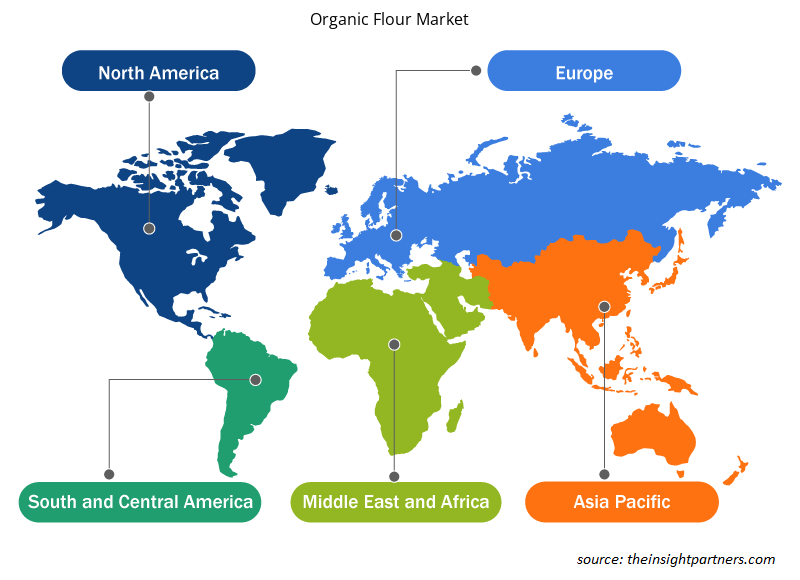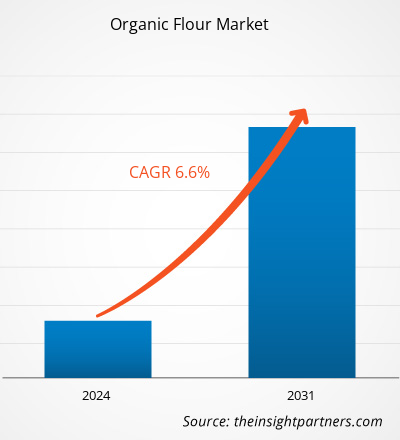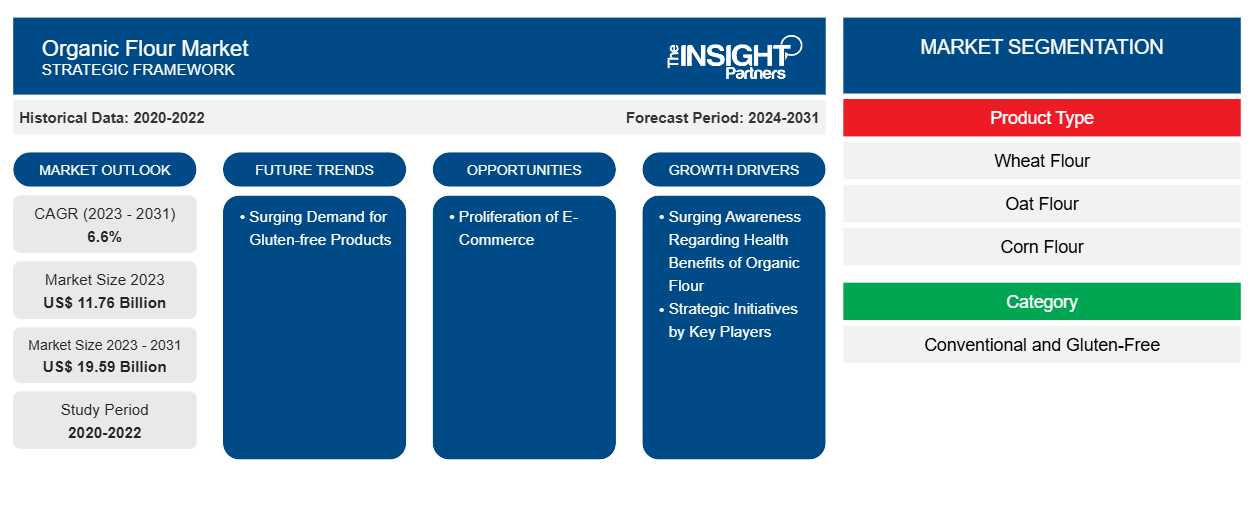Der Markt für Biomehl soll von 11,76 Milliarden US-Dollar im Jahr 2023 auf 19,59 Milliarden US-Dollar im Jahr 2031 wachsen; für den Zeitraum von 2023 bis 2031 wird eine durchschnittliche jährliche Wachstumsrate (CAGR) von 6,6 % erwartet.
Markteinblicke und Analystenansichten:
Die Nachfrage nach Bio-Mehl ist stark gestiegen, da Verbraucher gesundheitsbewusster werden und Bio-Produkte suchen. Bio-Mehl wird aus Getreide hergestellt, das ohne giftige Pestizide, synthetische Düngemittel oder Gentechnik angebaut wird. Die Nachfrage ist stark gestiegen, da die Verbraucher zunehmend gesündere, umweltfreundlichere und ethisch einwandfreie Lebensmittel bevorzugen. Darüber hinaus haben der hohe Nährwert und die potenziellen gesundheitlichen Vorteile von Bio-Lebensmitteln zur steigenden Nachfrage beigetragen. Dieser Anstieg ist Teil des größeren Trends in der Bio-Lebensmittelbranche, die in den letzten Jahren ein erhebliches Wachstum verzeichnet hat. Darüber hinaus entscheiden sich viele Verbraucher aufgrund eines wachsenden Bewusstseins für ökologische Nachhaltigkeit für Bio-Produkte, um umweltfreundlichere landwirtschaftliche Praktiken zu unterstützen, bei denen Bodengesundheit und Artenvielfalt im Vordergrund stehen. Darüber hinaus trägt der Wunsch, lokale Landwirte und Kleinproduzenten zu unterstützen und Transparenz bei der Lebensmittelproduktion zu bieten, zur steigenden Nachfrage nach Bio-Mehl bei.
Wachstumstreiber und Herausforderungen:
Strategische Initiativen wie Fusionen und Übernahmen, Partnerschaften, Kampagnenstarts und Produkteinführungen verschiedener Marktteilnehmer zur Stärkung ihrer Positionen und Nutzung neuer Chancen dürften zum Wachstum des Bio-Mehl-Marktes beitragen . So erwarb ADM im Jahr 2020 die restlichen 50 % der Anteile an dem in Großbritannien ansässigen Bio-Mehlmühlenunternehmen Gleadell Agriculture Ltd. Durch diese Übernahme konnte ADM seine Präsenz auf dem Bio-Mehl-Markt ausbauen und seine Lieferkettenkapazitäten stärken. Kampagnenstarts zur Sensibilisierung und Aufklärung der Verbraucher über die Vorteile von Bio-Mehl spielen ebenfalls eine wichtige Rolle für das Marktwachstum. Wichtige Akteure investieren oft in Marketingkampagnen, die die ernährungsphysiologischen Vorteile, die ökologische Nachhaltigkeit und die Qualitätsstandards von Bio-Mehl hervorheben. Diese Kampagnen tragen dazu bei, Nachfrage zu schaffen, Verbraucherpräferenzen zu formen und Bio-Mehlprodukte von herkömmlichen Alternativen abzuheben. Diese Kampagnen umfassen digitale Werbung , Social-Media-Aktionen und Bildungsinhalte, um das Bewusstsein der Verbraucher für die Vorteile der Verwendung von Bio-Mehl beim Backen und Kochen zu schärfen.
Produkteinführungen sind unerlässlich, um die Wettbewerbsfähigkeit aufrechtzuerhalten und den sich entwickelnden Verbraucherpräferenzen auf dem Markt für Biomehl gerecht zu werden. Wichtige Akteure entwickeln ständig Innovationen und bringen neue Biomehlprodukte auf den Markt, die auf spezifische Ernährungsbedürfnisse, Geschmacksvorlieben und Anlässe zugeschnitten sind. So richten sich beispielsweise glutenfreie Biomehlvarianten an Verbraucher mit Glutenunverträglichkeit oder -empfindlichkeit, während Spezialmehle wie Mandelmehl oder Kokosmehl gesundheitsbewusste Verbraucher ansprechen, die nach alternativen Backzutaten suchen. So führte Hodgson Mill im Jahr 2021 eine neue Linie von Biomehl ein, darunter Bio-Vollkornmehl, Bio-Allzweckmehl und Bio-Gebäckmehl, um Verbraucher anzusprechen, die nach Bio-Alternativen für ihre Backbedürfnisse suchen, und um Hodgson Mills Engagement zu demonstrieren, die wachsende Nachfrage nach Biomehloptionen zu erfüllen. Darüber hinaus betreten mehrere Unternehmen den Biomarkt, indem sie Produkte wie Biomehl auf den Markt bringen.
Es wird erwartet, dass die mit Biomehl verbundenen regulatorischen Auflagen wie strenge Standards und Zertifizierungsverfahren, die von Aufsichtsbehörden wie dem USDA und der EU-Bio-Verordnung vorgeschrieben werden, das globale Wachstum des Biomehlmarktes bremsen werden. Der Erwerb einer Bio-Zertifizierung erfordert umfassende Inspektionen, Dokumentation und die Einhaltung spezifischer Praktiken des ökologischen Landbaus, was alles einen erheblichen Zeit- und Finanzaufwand seitens der Produzenten erfordert. Dieser aufwändige Prozess kann für kleinere Produzenten oder solche mit begrenzten Ressourcen abschreckend wirken und die Möglichkeit behindern, in den Biomehlmarkt einzusteigen oder dort zu expandieren.
Passen Sie diesen Bericht Ihren Anforderungen an
Sie erhalten kostenlose Anpassungen an jedem Bericht, einschließlich Teilen dieses Berichts oder einer Analyse auf Länderebene, eines Excel-Datenpakets sowie tolle Angebote und Rabatte für Start-ups und Universitäten.
-
Holen Sie sich die wichtigsten Markttrends aus diesem Bericht.Dieses KOSTENLOSE Beispiel umfasst eine Datenanalyse von Markttrends bis hin zu Schätzungen und Prognosen.
Berichtssegmentierung und -umfang:
Die „Globale Marktanalyse für Biomehl“ wurde unter Berücksichtigung der folgenden Segmente durchgeführt: Produkttyp, Kategorie, Vertriebskanal und Geografie. Basierend auf dem Produkttyp ist der Markt für Biomehl in Weizenmehl, Hafermehl, Maismehl, Reismehl und andere unterteilt. Basierend auf der Kategorie ist der Markt in konventionell und glutenfrei unterteilt. Nach Vertriebskanal ist der Markt in Supermärkte und Hypermärkte, Convenience Stores, Online-Einzelhandel und andere unterteilt. Der geografische Umfang des Berichts zum Markt für Biomehl konzentriert sich auf Nordamerika (USA, Kanada und Mexiko), Europa (Deutschland, Frankreich, Italien, Großbritannien, Russland und der Rest Europas), Asien-Pazifik (Australien, China, Japan, Indien, Südkorea und der Rest des Asien-Pazifik-Raums), den Nahen Osten und Afrika (Südafrika, Saudi-Arabien, die Vereinigten Arabischen Emirate und der Rest des Nahen Ostens und Afrikas) sowie Süd- und Mittelamerika (Brasilien, Argentinien und der Rest von Süd- und Mittelamerika).
Segmentanalyse:
Je nach Produkttyp ist der Markt in Weizenmehl, Hafermehl, Maismehl, Reismehl und andere unterteilt. Je nach Typ wird erwartet, dass das glutenfreie Segment bis 2030 einen bedeutenden Marktanteil bei Biomehl halten wird. Glutenfreies Mehl ist für Personen gedacht, die an Zöliakie oder Glutenunverträglichkeit leiden und sich für eine glutenfreie Ernährung entscheiden. Die Nachfrage nach Produkten mit der Aufschrift „glutenfrei“ ist aufgrund der zunehmenden Verbreitung glutenbedingter Erkrankungen und eines breiteren Trends zu mehr Gesundheitsbewusstsein stark angestiegen. Laut Beyond Celiac leidet in den USA einer von 133 Amerikanern oder etwa 1 % der Bevölkerung an Zöliakie. Das Bewusstsein für Zöliakie hat viele Verbraucher dazu veranlasst, nach glutenfreien Alternativen zu suchen, wodurch ein beträchtlicher Markt für Produkte entstanden ist, die Ernährungseinschränkungen berücksichtigen. Darüber hinaus hat die Wahrnehmung, dass glutenfreie Optionen gesünder sein könnten, die Verbraucherbasis über Menschen mit medizinischen Beschwerden hinaus erweitert und zum anhaltenden Wachstum des Biomehlmarktes für das glutenfreie Segment beigetragen.
Regionale Analyse:
Geografisch ist der Markt in fünf Schlüsselregionen unterteilt: Nordamerika, Europa, Asien-Pazifik, Süd- und Mittelamerika sowie Naher Osten und Afrika. In Bezug auf den Umsatz dominierte Nordamerika den globalen Marktanteil von Biomehl. Der Markt in Nordamerika machte im Jahr 2023 ca. 2.900 Millionen US-Dollar aus. Der Markt für Biomehl im Asien-Pazifik-Raum wird im Prognosezeitraum voraussichtlich mit der höchsten CAGR wachsen. Der Asien-Pazifik-Raum erlebt eine schnelle Urbanisierung und verändert den Lebensstil der Verbraucher. Städtische Verbraucher suchen Biomehl als wichtige Zutat für selbstgebackenes Brot, Gebäck und andere Backwaren. Außerdem wurde der Trend zum Backen zu Hause durch Faktoren wie die COVID-19-Pandemie beschleunigt, die mehr Verbraucher dazu veranlasste, das Kochen und Backen zu Hause auszuprobieren. Infolgedessen ist die Nachfrage nach Biomehl als vielseitige und nahrhafte Backzutat im Asien-Pazifik-Raum erheblich gestiegen, was die Marktexpansion unterstützt.
Der asiatisch-pazifische Raum ist Heimat vielfältiger landwirtschaftlicher Landschaften und traditioneller landwirtschaftlicher Praktiken und bietet reichlich Gelegenheit für die Produktion von Biomehl. Länder wie Indien, China und Australien haben einen Anstieg von Initiativen für den ökologischen Landbau erlebt, unterstützt durch staatliche Maßnahmen zur Förderung nachhaltiger Landwirtschaft und Biozertifizierungsprogramme. Dieses wachsende Interesse am ökologischen Landbau hat die Verfügbarkeit von Biogetreide und -mehl in der Region erhöht. Das zunehmende Bewusstsein für Gesundheit und Wohlbefinden treibt das Wachstum des Biomehlmarktes im asiatisch-pazifischen Raum voran.
Europa leistet einen weiteren wichtigen Beitrag und hält mehr als 30 % des weltweiten Marktanteils. Verbraucher in ganz Europa sind zunehmend besorgt über Lebensmittelsicherheit, ökologische Nachhaltigkeit und die Auswirkungen landwirtschaftlicher Praktiken auf die öffentliche Gesundheit. Dies hat zu einer wachsenden Vorliebe für Bioprodukte, einschließlich Mehl, geführt. Verbraucher in Europa suchen aktiv nach Biomehl, das ohne synthetische Pestizide, Herbizide oder GVO hergestellt wurde, da sie es als viel sicherere und umweltfreundlichere Alternative als herkömmliches Mehl betrachten. Dieser Trend hin zu Biomehl wird auch durch veränderte Lebensstile und Ernährungsvorlieben der Verbraucher vorangetrieben, wobei sich viele Europäer für gesündere und natürlichere Lebensmittel entscheiden.
Regionale Einblicke in den Markt für Biomehl
Die regionalen Trends und Faktoren, die den Markt für Biomehl im Prognosezeitraum beeinflussen, wurden von den Analysten von Insight Partners ausführlich erläutert. In diesem Abschnitt werden auch die Marktsegmente und die Geografie des Biomehls in Nordamerika, Europa, im asiatisch-pazifischen Raum, im Nahen Osten und Afrika sowie in Süd- und Mittelamerika erörtert.

- Erhalten Sie regionale Daten zum Bio-Mehlmarkt
Umfang des Marktberichts zu Bio-Mehl
| Berichtsattribut | Details |
|---|---|
| Marktgröße im Jahr 2023 | 11,76 Milliarden US-Dollar |
| Marktgröße bis 2031 | 19,59 Milliarden US-Dollar |
| Globale CAGR (2023 - 2031) | 6,6 % |
| Historische Daten | 2020-2022 |
| Prognosezeitraum | 2024–2031 |
| Abgedeckte Segmente |
Nach Produkttyp
|
| Abgedeckte Regionen und Länder |
Nordamerika
|
| Marktführer und wichtige Unternehmensprofile |
|
Marktdichte von Biomehl: Auswirkungen auf die Geschäftsdynamik verstehen
Der Markt für Biomehl wächst rasant, angetrieben durch die steigende Nachfrage der Endverbraucher aufgrund von Faktoren wie sich entwickelnden Verbraucherpräferenzen, technologischen Fortschritten und einem größeren Bewusstsein für die Vorteile des Produkts. Mit der steigenden Nachfrage erweitern Unternehmen ihr Angebot, entwickeln Innovationen, um die Bedürfnisse der Verbraucher zu erfüllen, und nutzen neue Trends, was das Marktwachstum weiter ankurbelt.
Die Marktteilnehmerdichte bezieht sich auf die Verteilung der Firmen oder Unternehmen, die in einem bestimmten Markt oder einer bestimmten Branche tätig sind. Sie gibt an, wie viele Wettbewerber (Marktteilnehmer) in einem bestimmten Marktraum im Verhältnis zu seiner Größe oder seinem gesamten Marktwert präsent sind.
Die wichtigsten auf dem Markt für Biomehl tätigen Unternehmen sind:
- Heimatstadt-Lebensmittelunternehmen
- Bob's Red Mill Naturkost
- King Arthur Bäckerei
- koRo
- Betterbody Foods C/O
- FWP Matthews Ltd
Haftungsausschluss : Die oben aufgeführten Unternehmen sind nicht in einer bestimmten Reihenfolge aufgeführt.

- Überblick über die wichtigsten Akteure auf dem Markt für Bio-Mehl
Branchenentwicklungen und zukünftige Chancen:
Die Marktprognose für Biomehl kann den Beteiligten bei der Planung ihrer Wachstumsstrategien helfen. Im Folgenden sind die Initiativen der wichtigsten Akteure auf dem Markt für Biomehl aufgeführt:
- Im Jahr 2022 kündigte der Molkereikonzern GCMMF, der seine Produkte unter der Marke Amul vertreibt, mit der Einführung von Bio-Weizenmehl seinen Einstieg in den Bio-Lebensmittelmarkt an. Das erste Produkt in diesem Portfolio ist „Amul Organic Whole Wheat Atta“.
Wettbewerbslandschaft und Schlüsselunternehmen:
Hometown Food Company, Bob's Red Mill Natural Foods, Betterbody Foods C/O, FWP Matthews Ltd, Shipton Mill Ltd, W and H Marriage and Sons Limited, Gilchesters Organics und Anita's Organic Grain & Flour Mill Ltd. gehören zu den führenden Akteuren, die im Biomehl-Marktbericht vorgestellt werden. Akteure, die auf dem globalen Markt tätig sind, konzentrieren sich darauf, qualitativ hochwertige Produkte anzubieten, um die Kundennachfrage zu erfüllen. Sie verfolgen auch verschiedene Strategien wie die Einführung neuer Produkte, Kapazitätserweiterungen, Partnerschaften und Kooperationen, um auf dem Markt wettbewerbsfähig zu bleiben.
- Historische Analyse (2 Jahre), Basisjahr, Prognose (7 Jahre) mit CAGR
- PEST- und SWOT-Analyse
- Marktgröße Wert/Volumen – Global, Regional, Land
- Branchen- und Wettbewerbslandschaft
- Excel-Datensatz
Aktuelle Berichte
Erfahrungsberichte
Grund zum Kauf
- Fundierte Entscheidungsfindung
- Marktdynamik verstehen
- Wettbewerbsanalyse
- Kundeneinblicke
- Marktprognosen
- Risikominimierung
- Strategische Planung
- Investitionsbegründung
- Identifizierung neuer Märkte
- Verbesserung von Marketingstrategien
- Steigerung der Betriebseffizienz
- Anpassung an regulatorische Trends























 Kostenlose Probe anfordern für - Bio-Mehlmarkt
Kostenlose Probe anfordern für - Bio-Mehlmarkt